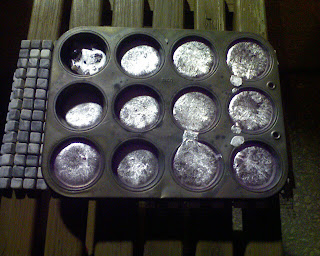Good Metals:
- Anything already machined
- Aluminum engine intake manifolds
- Aluminum loading dock plates
- Aluminum industrial kitchen supplies, such as mixing bowl hooks
Bad Metals:
- Anything really thin; including siding, aluminum cans, etc
- Anything with a lot of paint on it
One of the key things to avoid are objects with lots of surface area. The more exposed aluminum is to air the more oxidized it becomes, which in turn means the lower quality the actual ingots will be when they are produced. Another thing to watch out for is lots of paint and oils, these produce an increased amount of dross (waste) in the metal. Aluminum cans have both of these problems, they are HEAVILY oxidized and produce almost HALF dross!
Metal Cupcakes!
Metal that is processed needs to be stored in a way that makes it easy to reuse. Anything made of steel can be used as an ingot mold, so we use steel cupcake molds. These are small and easy to add to a crucible but I'd love to get a REAL mold for ingots that would allow each unit to be larger.
The following process is done for each batch of metal:
- Cleaning - Remove all non-metal parts, oils, and waste. This cannot be underemphesized. Nothing is worse than making a casting and pouring a steel o-ring into your mold that was left over from a poorly cleaned charge.
- Degassing - Hydrogen and other gasses that are being held in the metal can be removed by adding degassifiers to the liquid metal.
- Flux - Adding a flux assists the separation of impurities in the metal which then float to the top and can then be scooped out and discarded.
Unfortunately a lot of the information about this stuff falls under Metallurgy, which I have not even a passing knowledge of. I've queued up a few basic Metallurgy readings but I have no idea when I will get to learning more about it.
I have heard that 'washing soda' can work as a degasser for AL but have never found any. That name is common in the UK apparently but I have not figured out what it is in the US. Regular Salt functions as a Flux agent for AL and you can really tell when you add some. To add agents to liquid AL I always measure it out, put it in aluminum foil, and then drop it in that way. It just FEELS safer, you see. You then need to push the packet to the bottom of the crucible, and watch as the whole thing bubbles.
Recently we have started using an engineered solution, seen above. By using this is added a HUGE amount of dross is formed compared to just using salt. As this is the only engineered additive I've tried I can't compare it to others, but I can tell the difference in the final ingots. When knocked together they make a significantly clearer chiming noise, the metal is shinier, and they even weigh slightly less (about 5% less in the two I compared).
Recently we have started using an engineered solution, seen above. By using this is added a HUGE amount of dross is formed compared to just using salt. As this is the only engineered additive I've tried I can't compare it to others, but I can tell the difference in the final ingots. When knocked together they make a significantly clearer chiming noise, the metal is shinier, and they even weigh slightly less (about 5% less in the two I compared).
After this has happened you use a spoon, large or small but always of Iron, to scoop the stuff off the top of the liquid metal. This dross is MUCH thicker than the regular metal and will drain through a slotted spoon. I keep a cast iron skillet under the drain hole of the furnace (an emergency release for spilled metal) and drop it into the skillet. Don't ever FLICK the spoon, which is the instinct, because you WILL fling tiny balls of liquid metal around.
I got a carbide saw blade out of the trash one day (dull, they say. HA!) and threw it in my miter saw. I've used this to cut aluminum dock plates and thick AL tubes into manageable pieces. This.... is probably a bad process for you to use. I hear good things about a simple grill being used to soften AL up enough to just mallet into hunks but I haven't tried it myself yet.
Anyway, I now have about 60lbs of aluminum in various ingots. About 5 of those are high grade pure AL laboratory ingots, which I hope to use when I start getting into designing and recreating alloys.


2 comments:
Those ingots look awfully familiar...
Washing Soda = sodium carbonate. Also called Soda crystals or Sal Soda. Used as a detergent, as a descaling agent for coffee pots and the like, and is also a food additive, as an anti-caking agent, among other things.
http://en.wikipedia.org/wiki/Sodium_carbonate
Post a Comment